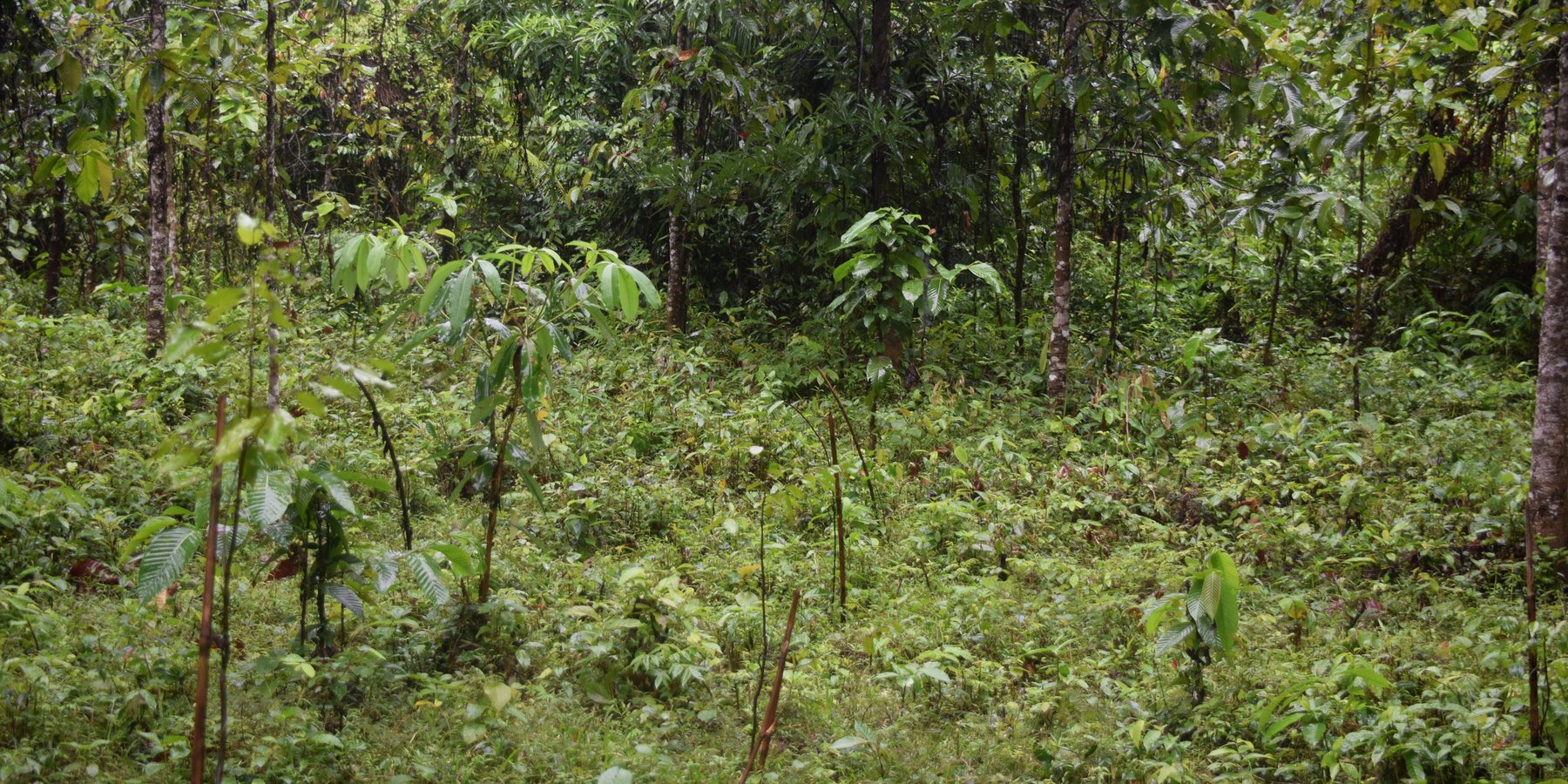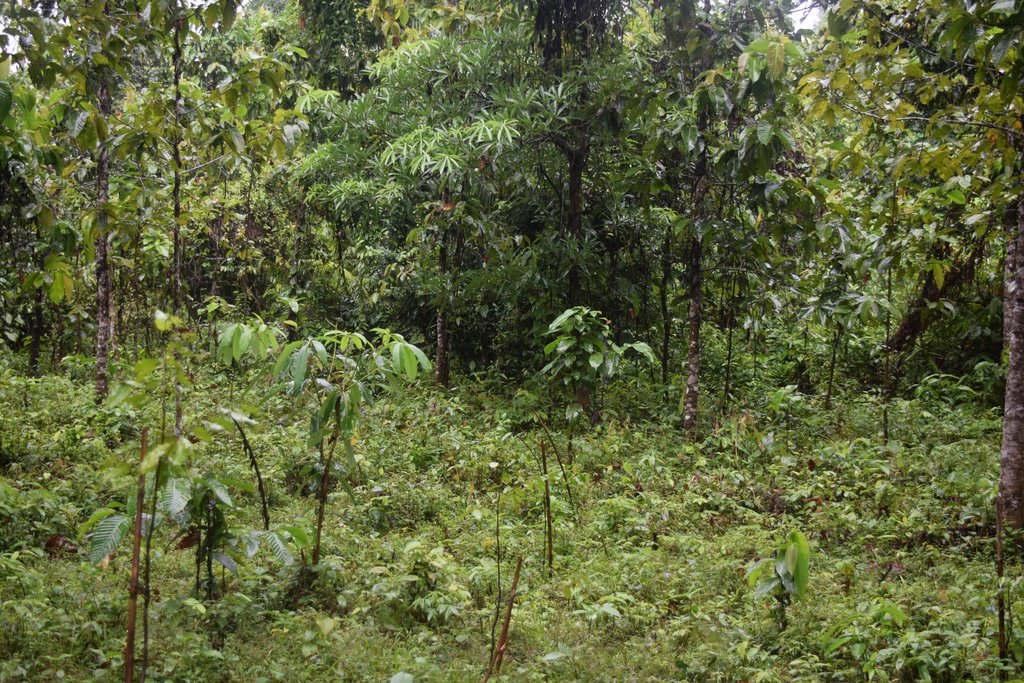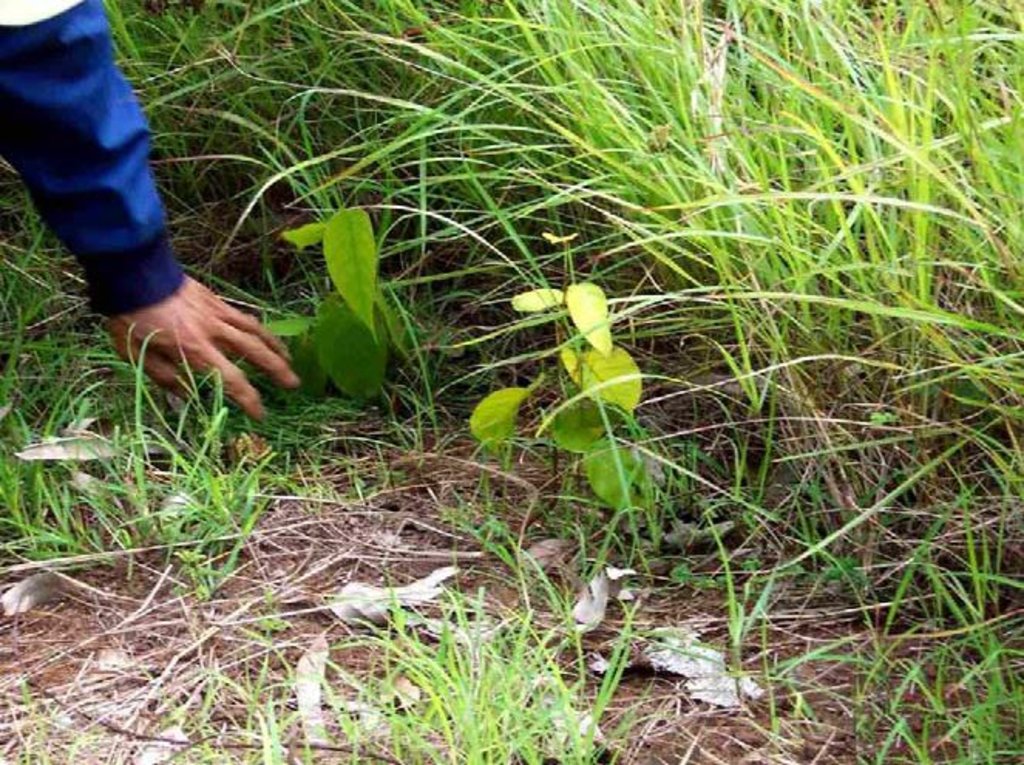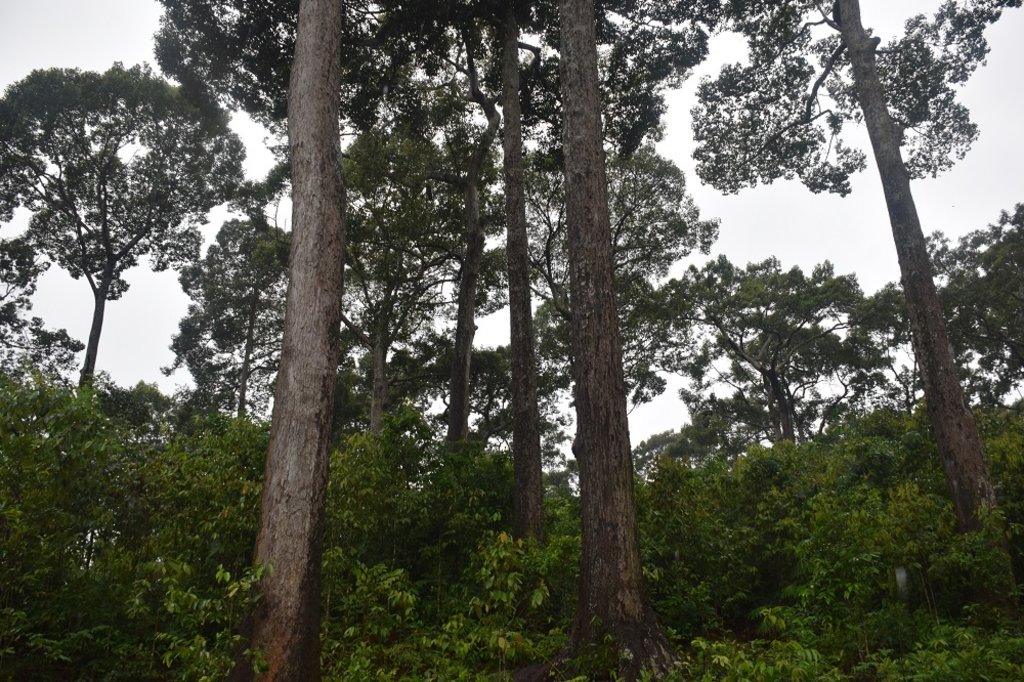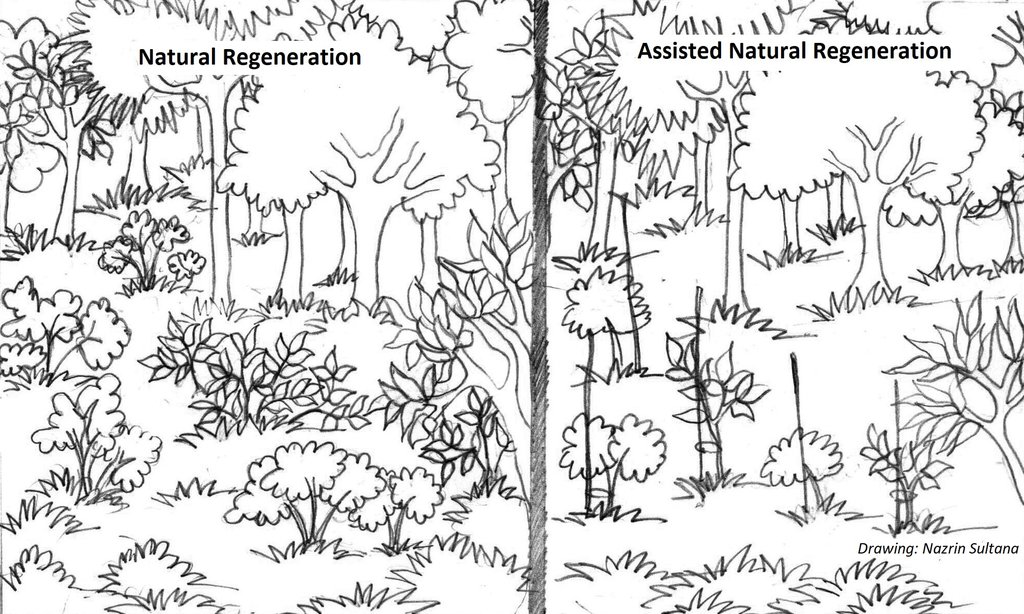Assisted Natural Regeneration [ប្រទេសបង់ក្លាដែស]
- ការបង្កើត៖
- បច្ចុប្បន្នភាព
- អ្នកចងក្រង៖ Fazlay Arafat
- អ្នកកែសម្រួល៖ –
- អ្នកត្រួតពិនិត្យច្រើនទៀត៖ Nicole Harari, Rima Mekdaschi Studer, Ursula Gaemperli
ANR
technologies_4372 - ប្រទេសបង់ក្លាដែស
ពិនិត្យមើលគ្រប់ផ្នែក
ពង្រីកមើលទាំងអស់ បង្រួមទាំងអស់1. ព័ត៌មានទូទៅ
1.2 ព័ត៌មានលម្អិតពីបុគ្គលសំខាន់ៗ និងស្ថាប័នដែលចូលរួមក្នុងការវាយតម្លៃ និងចងក្រងឯកសារនៃបច្ចេកទេស
បុគ្គលសំខាន់ម្នាក់ (ច្រើននាក់)
អ្នកប្រើប្រាស់ដី:
Morshed Hoq Mahabub
Bangladesh Forest Department
ប្រទេសបង់ក្លាដែស
អ្នកប្រើប្រាស់ដី:
Islam Md. Saiful
Bangladesh Forest Department
ប្រទេសបង់ក្លាដែស
អ្នកប្រើប្រាស់ដី:
Rahman Md.
Community Patrolling Group (CPG), Medhakocchopia
ប្រទេសបង់ក្លាដែស
ឈ្មោះគម្រោងដែលបានចងក្រងឯកសារ/ វាយតម្លៃលើបច្ចេកទេស (បើទាក់ទង)
Decision Support for Mainstreaming and Scaling out Sustainable Land Management (GEF-FAO / DS-SLM)ឈ្មោះអង្គភាពមួយ (ច្រើន) ដែលបានចងក្រងឯកសារ/ វាយតម្លៃបច្ចេកទេស (បើទាក់ទង)
Bangladesh Forest Department (Bangladesh Forest Department) - ប្រទេសបង់ក្លាដែសឈ្មោះអង្គភាពមួយ (ច្រើន) ដែលបានចងក្រងឯកសារ/ វាយតម្លៃបច្ចេកទេស (បើទាក់ទង)
FAO Bangladesh (FAO Bangladesh) - ប្រទេសបង់ក្លាដែស1.3 លក្ខខណ្ឌទាក់ទងទៅនឹងការប្រើប្រាស់ទិន្នន័យដែលបានចងក្រងតាមរយៈ វ៉ូខេត
អ្នកចងក្រង និង(បុគ្គលសំខាន់ៗ)យល់ព្រមទទួលយកនូវលក្ខខណ្ឌនានាទាក់ទងទៅនឹងការប្រើប្រាស់ទិន្នន័យដែលបានចងក្រងតាមរយៈវ៉ូខេត:
បាទ/ចា៎
1.4 សេចក្តីប្រកាសស្តីពីចីរភាពនៃការពណ៌នាពីបច្ចេកទេស
តើបច្ចេកទេសដែលបានពណ៌នានេះមានបញ្ហាដែលផ្តោតលើការធ្លាក់ចុះគុណភាពដី, បើដូច្នេះវាមិនអាចត្រូវបានប្រកាសថាជាបច្ចេកទេសនៃការគ្រប់គ្រងប្រកបដោយចីរភាពទេ?
ទេ
2. ការពណ៌នាពីបច្ចេកទេស SLM
2.1 ការពណ៌នាដោយសង្ខេបពីបច្ចេកទេស
និយមន័យបច្ចេកទេស:
Assisted natural regeneration (ANR) is a simple, low-cost forest restoration method that can effectively convert deforested lands to more productive forests.
2.2 ការពណ៌នាលម្អិតពីបច្ចេកទេស
ការពណ៌នា:
Medhakachapia National Park (MKNP) is nationally known for protecting the most extensive stands of mature critically endangered Garjan (Dipterocarpus turbinatus) trees in Bangladesh. Other native trees present in MKNP include Telsur Hopea odorata, Boilam Anisoptera scaphula, Gamar Gmelina arborea and Chapalish Artocarpus chaplasha. MKNP is tropical semi-evergreen forest in the low hills of the Fulchari Forest Range and covers 396 hectares. The park is located in Chakaria Upazila, not far from Cox’s Bazar in the southeast part of the country. Originally, the entire park area was densely covered with Garjan forest, but now there are about 9000 mature Garjan trees as many parts have been encroached upon with agriculture. MKNP is bordered by 13 villages where most of the people depend directly or indirectly upon the forest. Encroachment by settlements and agriculture has been associated with illegal tree cutting, hunting, and collection of fuel wood, bamboo and cane and other forest products. These activities are encouraged by sawmills in the vicinity and unemployment. Due to reduced canopy coverage, the forest soils have been exposed degraded. In order to restore forest health, the Bangladesh Forest Department introduced Assisted Natural Regeneration (ANR) practice. The access for public recreation and education and research is allowed inside national park. However, the collection of fuel woods and non-timber forest product from national park area by the local communities is a common scenario here.
ANR aims to accelerate, rather than replace, natural succession processes by removing or reducing barriers to natural forest regeneration such as competition with weedy species and recurring disturbances (e.g., fuel wood collection, grazing, fire and wood harvesting). Compared to conventional reforestation methods, which involve planting tree seedlings, ANR offers the significant advantage avoiding costs associated with propagating, raising, and planting seedlings. ANR is most effectively utilized at the landscape level in restoring the forest protective functions, such as soil protection, and is most suitable for restoring areas where some level of natural succession is already in progress. ANR offers distinct advantages over other forest restoration methods but also has some limitations. ANR is much cheaper to implement and can be applied over larger areas than other restoration planting approaches, but may be less effective in enhancing floristic diversity at the initial stages. Some of ANR’s disadvantages can be overcome by enrichment planting with desirable species. ANR aims to accelerate, rather than replace natural succession process by removing or reducing barriers to natural forest regeneration.
Soil degradation of MKNP has been greatly reduced through practicing ANR and co-management. In MKNP co-management was established on 2009 engaging local communities. As a part of co-management activities, the Forest Department (FD) formed a Community Patrolling Group (CPG) with 35 members from the local community to protect the Garjan trees and look after the whole forest along with forester officers. Under the support from Climate-Resilient Ecosystems and Livelihoods (CREL) project of USAID, the CPG along with FD intensively patrol the forest in rotating groups to ensure that no harm is done to the mature trees and natural seedlings. As a result, sufficient tree regeneration is now taking place and their growth is accelerating. Even where weeds dominate, seedlings of pioneer tree species are often found. The minimum required number of preexisting seedlings to implement ANR depends on the acceptable length of time for the forest to be restored and site-specific conditions that influence the rate of forest recovery. As a general reference, a density range of 200–800 seedlings/ha (>15 cm in height; counting clumps in 1 m2 as one seedling) has been suggested for ANR reforestation, and it has been estimated that at least 700 seedlings/ha are needed during the early treatment period in order to achieve canopy closure within three years. Although the forest restored through ANR in MKNP will have lower commercial value in terms of timber, it will support greater biodiversity and more effectively provide for the subsistence needs of the local people compared to commercial plantations.
2.3 រូបភាពនៃបច្ចេកទេស
2.5 ប្រទេស/តំបន់/ទីតាំងកន្លែង ដែលបច្ចេកទេសត្រូវបានអនុវត្ត និងបានគ្រប់ដណ្តប់ដោយការវាយតម្លៃនេះ
ប្រទេស:
ប្រទេសបង់ក្លាដែស
តំបន់/រដ្ឋ/ខេត្ត:
Chittagong division
បញ្ជាក់បន្ថែមពីលក្ខណៈនៃទីតាំង:
Medakacchapia National Park under Cox's Bazar North Forest division
បញ្ជាក់ពីការសាយភាយនៃបច្ចេកទេស:
- ត្រូវបានផ្សព្វផ្សាយត្រឹមតំបន់មួយ
ប្រសិនបើមិនច្បាស់ពីទំហំផ្ទៃដី សូមធ្វើការប៉ាន់ប្រម៉ាណ:
- 1-10 គម2
តើបច្ចេកទេស (មួយ ឬច្រើន) ទាំងនោះស្ថិតនៅក្នុងតំបន់ការពារជាអចិន្ត្រៃយ៍ណាមួយដែរឬទេ?
បាទ/ចា៎
បើបាទ/ច៎ា សូមបញ្ជាក់:
Medakacchapia is a National Park with an area of 395.92 ha. In Bangladesh, the access for public recreation and education/research is allowed inside national park. However, the collection of fuel woods and non-timber forest product from national park area by the local communities is a common scenario here.
Map
×2.6 កាលបរិច្ឆេទនៃការអនុវត្ត
បង្ហាញឆ្នាំនៃការចុះអនុវត្ត:
2014
2.7 ការណែនាំពីបច្ចេកទេស
សូមបញ្ជាក់តើបច្ចេកទេសត្រូវបានណែនាំឱ្យអនុវត្តដោយរបៀបណា:
- តាមរយៈគម្រោង / អន្តរាគមន៍ពីខាងក្រៅ
មតិយោបល់ (ប្រភេទនៃគម្រោង ។ល។):
Climate-Resilient Ecosystems and Livelihoods (CREL) project of USAID
3. ចំណាត់ថ្នាក់នៃបច្ចេកទេស SLM
3.1 គោលបំណងចម្បង (១ ឬច្រើន) នៃបច្ចេកទេសនេះ
- កាត់បន្ថយ, បង្ការ, ស្តារឡើងវិញនូវការធ្លាក់ចុះគុណភាពដី
- អភិរក្សប្រព័ន្ធអេកូឡូស៊ី
- អភិរក្ស/ធ្វើឱ្យប្រសើរឡើងជីវចម្រុះ
- បង្កើតផលប្រយោជន៍សង្គម
3.2 ប្រភេទដីប្រើប្រាស់មួយប្រភេទ (ច្រើនប្រភេទ) ដែលបានអនុវត្តបច្ចេកទេស
ដីប្រើប្រាស់ចម្រុះនៅលើដីតែមួយ:
ទេ

ដីព្រៃ/ដីដាំដើមឈើ
- ព្រៃ (ពាក់កណ្តាល) ធម្មជាតិ/ ដីព្រៃ
ព្រៃ (ពាក់កណ្តាល) ធម្មជាតិ / ដីព្រៃ៖ បញ្ជាក់ប្រភេទនៃការគ្រប់គ្រង:
- ឈើងាប់ៗ/ មែកដែលបាក់
- Tropical semi-evergreen forest
- Dipterocarpus turbinatus, Syzygium grande, Chukrasia tabularis, Hopea odorata
តើប្រភេទឈើខាងលើជាប្រភេទឈើក្នុងព្រៃល្បោះ ឬស្រោង?
- ព្រៃល្បោះចម្រុះ/ ព្រៃស្រោង
ផលិតផល និងសេវាកម្ម:
- ឈើហ៊ុប
- អុស
- ផ្លែឈើ និងគ្រាប់ធញ្ញជាតិ
- ការអភិរក្ស/ការការពារធម្មជាតិ
- ការកំសាន្ត/ទេសចរណ៍
- Oil from Dipterocarpus turbinatus
3.3 បន្ទាប់ពីអនុវត្តបច្ចេកទេស តើដីប្រើប្រាស់មានការប្រែប្រួលដែររឺទេ?
បន្ទាប់ពីអនុវត្តបច្ចេកទេស តើដីប្រើប្រាស់មានការប្រែប្រួលដែររឺទេ?
- ទេ (បន្តទៅសំណួរ 3.4)
3.4 ការផ្គត់ផ្គង់ទឹក
ការផ្គត់ផ្គង់ទឹកនៅកន្លែងអនុវត្តបច្ចេកទេស:
- ទឹកភ្លៀង
3.5 ក្រុម SLM ដែលបច្ចេកទេសស្ថិតនៅក្នុង
- ការគ្រប់គ្រងព្រៃធម្មជាតិ និងព្រៃពាក់កណ្តាលធម្មជាតិ
- ធ្វើឱ្យប្រសើរឡើងគម្របដី/ ដំណាំគម្របដី
3.6 វិធានការ SLM ដែលបញ្ចូលនូវបច្ចេកទេស

វិធានការរុក្ខជាតិ
- V1: ឈើធំៗ និងដើមឈើតូចៗ

វិធានការគ្រប់គ្រង
- M2: ការផ្លាស់ប្តូរការគ្រប់គ្រង/ កម្រិតអាំងតង់ស៊ីតេ
មតិយោបល់:
Earlier the ground vegetation was suppressed by weeds and non-valuable plant species. Various alien invasive plant species also disturbed the natural succession process of these area. The management practice also changed from plantation in vacant area to assisted natural regeneration with the involvement of local community.
3.7 កំណត់ប្រភេទនៃការធ្លាក់ចុះគុណភាពដីសំខាន់ៗដែលបច្ចេកទេសនេះបានដោះស្រាយ

ការហូរច្រោះដីដោយសារទឹក
- Wt: ការបាត់ដីស្រទាប់លើដោយការហូរច្រោះ
- Wg: ការកកើតឡើងនូវកំទេចកំទីដីស្រទាប់ក្រោម

ការធ្លាក់ចុះជីវសាស្ត្រនៃដី
- Bc: ការថយចុះនូវគម្របរុក្ខជាតិ
- Bq: ការថយចុះនូវជីវម៉ាស/ បរិមាណ
- Bs: សមាសភាពដែលមានគុណភាពនិងប្រភេទសត្វ/ការថយចុះនូវជីវចម្រុះ
3.8 ការពារ កាត់បន្ថយ ឬស្តារឡើងវិញនៃការធ្លាក់ចុះគុណភាពដី
បញ្ជាក់ពីគោលដៅរបស់បច្ចេកទេស ដែលផ្តោតទៅការធ្លាក់ចុះគុណភាពដី:
- ការកាត់បន្ថយការធ្លាក់ចុះគុណភាពដី
មតិយោបល់:
Canopy coverage of the area were poor and top soil erosion occurred due to exposed forest cover. Through ANR the canopy coverage will be regained and reduce land degradation.
4. បច្ចេកទេសជាក់លាក់ សកម្មភាពអនុវត្ត ធាតុចូល និងថ្លៃដើម
4.1 គំនូសបច្ចេកទេសនៃបច្ចេកទេសនេះ
លក្ខណៈពិសេសនៃបច្ចេកទេស (ទាក់ទងនឺងគំនូរបច្ចេកទេស):
Step 1: Marking of Woody Regeneration
Once the target area is identified and its boundaries are demarcated, the site is surveyed to assess its succession status and to locate any natural woody regeneration growing in the weedy vegetation. The located seedlings should be clearly marked with stakes. Decision on the minimum size of seedlings to be protected and released depends on the density and distribution of seedlings in the area, as well as budget and time constraints. However, the seedlings should be large enough to have a reasonable chance of survival.
Step 2: Liberation and Tending of Woody Regeneration
The next step is to accelerate the growth of the marked seedlings by reducing competition from the weedy species for water, nutrients, and light. The initial weeding and climber cutting should be implemented at the onset of the rainy season so that the liberated seedlings will have the full growing season of accelerated growth. All competing vegetation such as weeds and climbers within at least 0.5 m radius around the stem of the marked seedlings are removed. In some cases, clumps of woody seedlings may need to be thinned in order to liberate the largest individuals or the more desirable species.
Step 3: Protection from Disturbance.
Protecting against fire and other forms of disturbance is the most important ANR activity. Establishing firebreaks around blocks of ANR-treated sites is important, if the area is prone to fire. If animal grazing is prevalent in the area, fencing should be established, or patrols/guards should be assigned to protect the site from such activity. Long-term community involvement and support is critical in preventing the re-occurrence of disturbance events that will set back succession to the before-treatment state.
Step 4: Maintenance and Enrichment Planting.
It is suggested that the maintenance of weeding, and liberation of any additional seedlings that establish or that are newly found, should be conducted three times in first two years and two times in next two years. In the fifth year one climber cutting should be conducted in rainy season. The frequency of maintenance operations can be adjusted according to field observation and monitoring data on the growth of the liberated seedlings and the density of natural woody regeneration. Enrichment planting can also be carried out to accelerate canopy closure, add useful tree species, and increase floral diversity. Even after the restoration of canopy cover, large-seeded primary forest trees and rare species are unlikely to colonize naturally. If restoring some of the floral diversity of the original forest is one of the restoration objectives, species or functional groups of trees lacking in natural regeneration will need to be planted either at the initial treatment stage or after canopy closure depending on the ecological requirements of the species.
ឈ្មោះអ្នកនិពន្ធ:
Nazrin Sultana
កាលបរិច្ឆេទ:
16/04/2019
4.2 ព័ត៌មានទូទៅដែលពាក់ព័ន្ធនឹងការគណនាធាតុចូល និងថ្លៃដើម
កំណត់របៀបនៃការគណនាថ្លៃដើម និងធាតុចូល:
- ក្នុងតំបន់អនុវត្តបច្ចេកទេស
កំណត់ទំហំ និងឯកត្តាផ្ទៃដី:
1 hectare
បើសិនប្រើឯកតាតាមតំបន់ សូមបញ្ជាក់តម្លៃបម្លែងវាទៅជាហិកតា (ឧ. 1 ហិកតា = 2.47 អា)៖ 1 ហិកតា =:
1 ha = 2.47 acres
ផ្សេងៗ/ រូបិយប័ណ្ណជាតិ (បញ្ជាក់):
BDT
បើពាក់ព័ន្ធសូមកំណត់អត្រាប្តូរប្រាក់ពីដុល្លាទៅរូបិយប័ណ្ណតំបន់ (ឧ. 1 ដុល្លារ = 79.9 រៀលនៃរូបិយប័ណ្ណប្រេស៊ីល) ៖ 1 ដុល្លារ =:
84,0
កំណត់ថ្លៃឈ្នួលជាមធ្យមនៃការជួលកម្លាំងពលកម្មក្នុងមួយថ្ងៃ:
500 BDT
4.3 សកម្មភាពបង្កើត
| សកម្មភាព | រយៈពេល (រដូវកាល) | |
|---|---|---|
| 1. | Site preparation (Boundary demarcation, site map preparation with GPS, marking of woody regeneration) | May-June |
| 2. | Care and maintenance of natural regeneration (liberation and tending of woody regeneration, protection from disturbance) | June-July |
4.4 ថ្លៃដើម និងធាតុចូលដែលត្រូវការសម្រាប់ការបង្កើតបច្ចេកទេស
| បញ្ជាក់ពីធាតុចូល | ឯកតា | បរិមាណ | ថ្លៃដើមក្នុងមួយឯកតា | ថ្លៃធាតុចូលសរុប | % នៃថ្លៃដើមដែលចំណាយដោយអ្នកប្រើប្រាស់ដី | |
|---|---|---|---|---|---|---|
| កម្លាំងពលកម្ម | Survey for map preparation and marking of woody regeneration | person-days | 1,0 | 500,0 | 500,0 | |
| កម្លាំងពលកម្ម | Tying up seedlings and young trees | person-days | 4,0 | 500,0 | 2000,0 | |
| កម្លាំងពលកម្ម | Tending of woody regeneration | person-days | 10,0 | 500,0 | 5000,0 | |
| កម្លាំងពលកម្ម | Application of fertilizers | person-days | 4,0 | 500,0 | 2000,0 | |
| សម្ភារៈ | Weeding equipment (manual weeding tool) | lump sum | 1,0 | 1000,0 | 1000,0 | |
| សម្ភារៈ | Bamboo sticks for tying up seedlings | pieces | 800,0 | 2,0 | 1600,0 | |
| សម្ភារៈ | Rope | lump sum | 1,0 | 1000,0 | 1000,0 | |
| ជី និងសារធាតុពុល | Compost fertilizer | Kg | 625,0 | 4,0 | 2500,0 | |
| សម្ភារៈសាងសង់ | Rod, Cement, Sand, Khoa, etc for RCC signboard | Lump sum | 1,0 | 1000,0 | 1000,0 | |
| ថ្លៃដើមសរុបក្នុងការបង្កើតបច្ចេកទេស | 16600,0 | |||||
| ថ្លៃដើមសរុបក្នុងការបង្កើតបច្ចេកទេសគិតជាដុល្លារ | 197,62 | |||||
ប្រសិនបើអ្នកប្រើប្រាស់ដីមិនមានថ្លៃដើម 100% សូមបញ្ជាក់ថានរណាដែលចំណាយថ្លៃដើមដែលនៅសល់:
Bangladesh forest department is the land user and the total cost of the establishment borne by CREL project
4.5 សកម្មភាពថែទាំ
| សកម្មភាព | ពេលវេលា/ ភាពញឹកញាប់ | |
|---|---|---|
| 1. | 1st year weeding | 3 times |
| 2. | 2nd year weeding | 3 times |
| 3. | 3rd year weeding | 2 times |
| 4. | 4th year weeding | 2 times |
| 5. | 5th year climber cutting | 1 time |
4.6 កំណត់ថ្លៃដើមសម្រាប់ការថែទាំ/ សកម្មភាពរបស់បច្ចេកទេស (ក្នុងរយៈពេលមួយឆ្នាំ)
| បញ្ជាក់ពីធាតុចូល | ឯកតា | បរិមាណ | ថ្លៃដើមក្នុងមួយឯកតា | ថ្លៃធាតុចូលសរុប | % នៃថ្លៃដើមដែលចំណាយដោយអ្នកប្រើប្រាស់ដី | |
|---|---|---|---|---|---|---|
| កម្លាំងពលកម្ម | 1st year weeding | person-days | 15,0 | 500,0 | 7500,0 | |
| កម្លាំងពលកម្ម | 2nd year weeding | person-days | 15,0 | 500,0 | 7500,0 | |
| កម្លាំងពលកម្ម | 3rd year weeding | person-days | 10,0 | 500,0 | 5000,0 | |
| កម្លាំងពលកម្ម | 4th year weeding and 5th year climber cutting | person-days | 15,0 | 500,0 | 7500,0 | 100,0 |
| សម្ភារៈ | Weeding equipment (manual weeding tools) | lump sum | 1,0 | 1000,0 | 1000,0 | |
| ថ្លៃដើមសរុបសម្រាប់ការថែទាំដំណាំតាមបច្ចេកទេស | 28500,0 | |||||
| ថ្លៃដើមសរុបសម្រាប់ការថែទាំដំណាំតាមបច្ចេកទេសគិតជាដុល្លារ | 339,29 | |||||
ប្រសិនបើអ្នកប្រើប្រាស់ដីមិនមានថ្លៃដើម 100% សូមបញ្ជាក់ថានរណាដែលចំណាយថ្លៃដើមដែលនៅសល់:
The 4th year weeding and 5th year climber cutting borne by forest department
4.7 កត្តាសំខាន់បំផុតដែលមានឥទ្ធិពលដល់ការចំណាយ
ពណ៌នាពីកត្តាប៉ះពាល់ចម្បងៗទៅលើថ្លៃដើម:
The most important factor affecting the costs is labor
5. លក្ខណៈបរិស្ថានធម្មជាតិ និងមនុស្ស
5.1 អាកាសធាតុ
បរិមាណទឹកភ្លៀងប្រចាំឆ្នាំ
- < 250 មម
- 251-500 មម
- 501-750 មម
- 751-1,000 មម
- 1,001-1,500 មម
- 1,501-2,000 មម
- 2,001-3,000 មម
- 3,001-4,000 មម
- > 4,000 មម
កំណត់បរិមាណទឹកភ្លៀង (បើដឹង) ជា មីលីម៉ែត្រ:
3770,00
លក្ខណៈពិសេស/ មតិយោបល់លើរដូវភ្លៀង:
The driest month is December. The greatest amount of precipitation occurs in June.
តំបន់កសិអាកាសធាតុ
- សើម
Mean annual temperature is 25.6 °C
5.2 សណ្ឋានដី
ជម្រាលជាមធ្យម:
- រាបស្មើ (0-2%)
- ជម្រាលតិចតួច (3-5%)
- មធ្យម (6-10%)
- ជម្រាលខ្ពស់បន្តិច (11-15%)
- ទីទួល (16-30%)
- ទីទួលចោត (31-60%)
- ទីទួលចោតខ្លាំង (>60%)
ទម្រង់ដី:
- ខ្ពង់រាប
- កំពូលភ្នំ
- ជម្រាលភ្នំ
- ជម្រាលទួល
- ជម្រាលជើងភ្នំ
- បាតជ្រលងភ្នំ
តំបន់តាមរយៈកម្ពស់ :
- 0-100 ម
- 101-500 ម
- 501-1,000 ម
- 1,001-1,500 ម
- 1,501-2,000 ម
- 2,001-2,500 ម
- 2,501-3,000 ម
- 3,001-4,000 ម
- > 4,000 ម
បញ្ជាក់ថាតើបច្ចេកទេសនេះត្រូវបានអនុវត្តន៍នៅក្នុង:
- មិនពាក់ព័ន្ធទាំងអស់
5.3 ដី
ជម្រៅដីជាមធ្យម:
- រាក់ខ្លាំង (0-20 សម)
- រាក់ (21-50 សម)
- មធ្យម (51-80 សម)
- ជ្រៅ (81-120 សម)
- ជ្រៅខ្លាំង (> 120 សម)
វាយនភាពដី (ស្រទាប់លើ):
- មធ្យម (ល្បាយ, ល្បាប់)
វាយនភាពដី (> 20 សម ស្រទាប់ក្នុង):
- មធ្យម (ល្បាយ, ល្បាប់)
សារធាតុសរីរាង្គនៅស្រទាប់ដីខាងលើ:
- មធ្យម (1-3%)
5.4 ទឹកដែលអាចទាញមកប្រើប្រាស់បាន និងគុណភាពទឹក
នីវ៉ូទឹកក្រោមដី:
5-50 ម
ទឹកលើដីដែលអាចទាញយកប្រើប្រាស់បាន:
ល្អ
គុណភាពទឹក (មិនបានធ្វើប្រត្តិកម្ម):
ទឹកពិសារដែលគ្មានគុណភាព (តម្រូវឱ្យមានការសំអាត)
គុណភាពទឹក គឺផ្តោតទៅលើ៖:
ទឹកលើផ្ទៃដី
តើមានបញ្ហាភាពទឹកប្រៃហូរចូលមកដែរឬទេ?
ទេ
តើទឹកជំនន់កំពុងកើតមាននៅតំបន់នេះដែររឺទេ?
ទេ
5.5 ជីវៈចម្រុះ
ភាពសម្បូរបែបនៃប្រភេទ:
- កម្រិតមធ្យម
ភាពសម្បូរបែបនៃទីជម្រក:
- កម្រិតមធ្យម
5.6 លក្ខណៈនៃអ្នកប្រើប្រាស់ដីដែលអនុវត្តបច្ចេកទេស
នៅមួយកន្លែង ឬពនេចរ :
- នៅមួយកន្លែង
ទីផ្សារនៃប្រព័ន្ធផលិតកម្ម:
- ពាក់កណ្តាលពាណិជ្ជកម្ម (ផ្គត់ផ្គង់ខ្លួនឯង/ ពាណិជ្ជកម្ម)
ចំណូលក្រៅកសិកម្ម:
- តិចជាង 10% នៃចំណូល
កម្រិតជីវភាព:
- មិនល្អ
ឯកជន ឬក្រុម:
- មានបុគ្គលិក (ក្រុមហ៊ុន, រដ្ឋ)
កម្រិតប្រើប្រាស់គ្រឿងយន្ត:
- ប្រើកម្លាំងពលកម្ម
យេនឌ័រ:
- ស្ត្រី
- បុរស
អាយុរបស់អ្នកប្រើប្រាស់ដី:
- យុវវ័យ
- វ័យកណ្តាល
- មនុស្សចាស់
5.7 ទំហំផ្ទៃដីជាមធ្យមនៃដីប្រើប្រាស់ដោយអ្នកប្រើប្រាស់ដី ក្នុងការអនុវត្តបច្ចេកទេស
- < 0.5 ហិកតា
- 0.5-1 ហិកតា
- 1-2 ហិកតា
- 2-5 ហិកតា
- 5-15 ហិកតា
- 15-50 ហិកតា
- 50-100 ហិកតា
- 100-500 ហិកតា
- 500-1,000 ហិកតា
- 1,000-10,000 ហិកតា
- > 10,000 ហិកតា
តើផ្ទៃដីនេះចាត់ទុកជាទំហំកម្រិតណាដែរ ខ្នាតតូច មធ្យម ឬខ្នាតធំ (ធៀបនឹងបរិបទតំបន់)?
- ខ្នាតតូច
5.8 ភាពជាម្ចាស់ដី កម្មសិទ្ធប្រើប្រាស់ដី និងកម្មសិទ្ធប្រើប្រាស់ទឹក
ភាពជាម្ចាស់ដី:
- រដ្ឋ
កម្មសិទ្ធិប្រើប្រាស់ដី:
- ជាក្រុម (មានដែនកំណត់)
កម្មសិទ្ធប្រើប្រាស់ទឹក:
- អាស្រ័យផលសេរី (មិនមានការកំណត់)
តើកម្មសិទ្ធប្រើប្រាស់ដី គឺផ្អែកលើប្រព័ន្ធច្បាប់បែបបុរាណ?
ទេ
សូមបញ្ជាក់:
Under co-management system
មតិយោបល់:
Co-management of forest ensures active participation of all concerned parties in the management or maintenance of natural resources on the basis of consensus among the stakeholders involved in the management of the natural resources of an area
5.9 ការប្រើប្រាស់សេវាកម្ម និងហេដ្ឋារចនាសម្ព័ន្ធ
សុខភាព:
- មិនល្អ
- មធ្យម
- ល្អ
ការអប់រំ:
- មិនល្អ
- មធ្យម
- ល្អ
ជំនួយបច្ចេកទេស:
- មិនល្អ
- មធ្យម
- ល្អ
ការងារ (ឧ. ការងារក្រៅកសិដ្ឋាន):
- មិនល្អ
- មធ្យម
- ល្អ
ទីផ្សារ:
- មិនល្អ
- មធ្យម
- ល្អ
ថាមពល:
- មិនល្អ
- មធ្យម
- ល្អ
ផ្លូវ និងការដឹកជញ្ជូន:
- មិនល្អ
- មធ្យម
- ល្អ
ទឹកផឹក និងអនាម័យ:
- មិនល្អ
- មធ្យម
- ល្អ
សេវាកម្មហិរញ្ញវត្ថុ:
- មិនល្អ
- មធ្យម
- ល្អ
6. ផលប៉ះពាល់ និងការសន្និដ្ឋាន
6.1 ផលប៉ះពាល់ក្នុងបរិវេណអនុវត្តបច្ចេកទេសដែលកើតមាន
ផលប៉ះពាល់លើសេដ្ឋកិច្ចសង្គម
ផលិតផល
ផលិតកម្មឈើ
មតិយោបល់/ ការបញ្ជាក់:
ANR support the growth of woody vegetation and regular monitoring of ANR also provide security to the mature trees of the stand
គុណភាពព្រៃឈើ/ដីព្រៃ
អនុផលព្រៃឈើ
ហានិភ័យនៃភាពបរាជ័យរបស់ផលិតកម្ម
ផ្ទៃដីផលិតកម្ម
មតិយោបល់/ ការបញ្ជាក់:
Through ANR the fellow and degraded forest land now bring under productive forest
ការគ្រប់គ្រងដី
មតិយោបល់/ ការបញ្ជាក់:
ANR is a comparatively easy method than clear felling with artificial regeneration, mixed plantation or enrichment plantation to manage forest area
ចំណូល និងថ្លៃដើម
ភាពសម្បូរបែបប្រភពប្រាក់ចំណូល
មតិយោបល់/ ការបញ្ជាក់:
The local communities can collect NTFP from the ANR site. Due to the increase of vegetation and presence of wildlife in MKNP, the area also attract tourists. The CPG people also worked as tourist guide
ផលប៉ះពាល់ទៅលើវប្បធម៌សង្គម
ឱកាសវប្បធម៍
មតិយោបល់/ ការបញ្ជាក់:
aesthetic beauty of forest improved
ឱកាសនៃការបង្កើតថ្មី
មតិយោបល់/ ការបញ្ជាក់:
eco-tourism increased
ចំណេះដឹង SLM / ការធ្លាក់ចុះគុណភាពដី
ស្ថានភាពក្រុមដែលមានបញ្ហាក្នុងសង្គម និងសេដ្ឋកិច្ច
មតិយោបល់/ ការបញ្ជាក់:
Poor people working in Community Patrolling Group (CPG) taking care of ANR with forest department. Social status of these poor people improved.
ផលប៉ះពាល់ទៅលើអេកូឡូស៊ី
វដ្តទឹក/លំហូរ
លំហូរទឹកលើផ្ទៃដី
នីវ៉ូទឹកក្រោមដី/ ដង្ហើមទឹក
រំហួត
មតិយោបល់/ ការបញ្ជាក់:
Due to increased canopy coverage evaporation decreased
ដី
សំណើមដី
គម្របដី
ការបាត់បង់ដី
វដ្តនៃសារធាតុចិញ្ចឹម/ការទទួលបាន
សារធាតុសរីរាង្គដី/ការបូនក្រោមដី
ជីវចម្រុះ៖ ដំណាំ, សត្វ
ដំណាំគម្រប
ជីវម៉ាស/ កាបូនលើដី
ភាពសម្បូរបែបនៃរុក្ខជាតិ
ប្រភេទរាតត្បាត
មតិយោបល់/ ការបញ្ជាក់:
Through ANR only native plant species promoted to grow here
ភាពសម្បូរបែបនៃសត្វ
មតិយោបល់/ ការបញ្ជាក់:
Animal diversity increased as the habitat improved
ប្រភេទសត្វមានប្រយោជន៍
ភាពសម្បូរបែបនៃទីជំរក
មតិយោបល់/ ការបញ្ជាក់:
habitat diversity increased with the canopy coverage and tree density improvement
ការកាត់បន្ថយហានិភ័យនៃគ្រោះមហន្តរាយ និងគ្រោះអាកាសធាតុ
ដីបាក់/ លំហូរកំទិចកំទី
ការបំភាយនៃកាបូន និងឧស្ម័នផ្ទះកញ្ចក់
6.2 ផលប៉ះពាល់ក្រៅបរិវេណអនុវត្តបច្ចេកទេសដែលកើតមាន
លំហូរទឹកដែលអាចប្រើប្រាស់បាននៅរដូវប្រាំង
មតិយោបល់/ ការបញ្ជាក់:
Due to the presence of vegetation on slope the stream flow become stable
កំណកល្បាប់ខ្សែទឹកខាងក្រោម
ផលប៉ះពាល់នៃឧស្ម័នផ្ទះកញ្ចក់
6.3 ភាពប្រឈម និងភាពរួសនៃបច្ចេកទេសទៅនឹងការប្រែប្រួលអាកាសធាតុ និងគ្រោះអាកាសធាតុ/ គ្រោះមហន្តរាយ (ដែលដឹងដោយអ្នកប្រើប្រាស់ដី)
ការប្រែប្រួលអាកាសធាតុ
ការប្រែប្រួលអាកាសធាតុ
| រដូវកាល | កើនឡើង ឬថយចុះ | លក្ខណៈឆ្លើយតបនៃបច្ចេកទេសទៅនឹងការប្រែប្រួលអាកាសធាតុ | |
|---|---|---|---|
| សីតុណ្ហភាពប្រចាំឆ្នាំ | កើនឡើង | ល្អ | |
| សីតុណ្ហភាពប្រចាំរដូវកាល | រដូវក្តៅ | កើនឡើង | ល្អ |
| បរិមាណទឹកភ្លៀងប្រចាំឆ្នាំ | ថយចុះ | មធ្យម | |
| បរិមាណទឹកភ្លៀងប្រចាំរដូវកាល | សើម/រដូវភ្លៀង | កើនឡើង | មធ្យម |
គ្រោះអាកាសធាតុ (មហន្តរាយ)
គ្រោះមហន្តរាយទឹក
| លក្ខណៈឆ្លើយតបនៃបច្ចេកទេសទៅនឹងការប្រែប្រួលអាកាសធាតុ | |
|---|---|
| ដីបាក់ | មិនល្អ |
មតិយោបល់:
Note to coping with landslides; Due to the events of landslides in the upper slope sometimes the seedlings and young trees suffered at the foot slope. The degraded upland area can be recovered through ANR with enrichment planting to reduces the events of landslides and slope stabilization.
6.4 ការវិភាគថ្លៃដើម និងអត្ថប្រយោជន៍
តើផលចំណេញ និងថ្លៃដើមត្រូវបានប្រៀបធៀបគ្នាយ៉ាងដូចម្តេច (ទស្សនៈរបស់អ្នកប្រើប្រាស់ដី)?
រយៈពេលខ្លី:
អវិជ្ជមានតិចតួច
រយៈពេលវែង:
វិជ្ជមានខ្លាំង
តើផលចំណេញ និងការថែទាំ/ ជួសជុលត្រូវបានប្រៀបធៀបគ្នាយ៉ាងដូចម្តេច (ទស្សនៈរបស់អ្នកប្រើប្រាស់ដី)?
រយៈពេលខ្លី:
អវិជ្ជមានតិចតួច
រយៈពេលវែង:
វិជ្ជមានខ្លាំង
6.5 ការទទួលយកបច្ចេកទេស
- 1-10%
ក្នុងចំណោមគ្រួសារទាំងអស់ដែលបានអនុវត្តបច្ចេកទេស តើមានប៉ុន្មានគ្រួសារដែលចង់ធ្វើដោយខ្លួនឯង ដោយមិនទទួលបានសម្ភារៈលើកទឹកចិត្ត/ប្រាក់ឧបត្ថម្ភ?:
- 91-100%
6.6 ការបន្សុំា
តើថ្មីៗនេះ បច្ចេកទេសនេះត្រូវបានកែតម្រូវដើម្បីបន្ស៊ាំទៅនឹងស្ថានភាពប្រែប្រួលដែរឬទេ?
ទេ
6.7 ភាពខ្លាំង/ គុណសម្បត្តិ/ ឱកាសនៃបច្ចេកទេស
| ភាពខ្លាំង/ គុណសម្បត្តិ/ ឱកាសនៅកន្លែងរបស់អ្នកប្រើប្រាស់ដី |
|---|
| It is a low cost intervention to regain the protective roles of the forest. |
| Community Patrolling Group (CPG) are involved in maintenance of ANR forest through co-management of natural resources. Regular patrolling activity reduces the disturbance in forest and help to prevent land degradation. |
| ភាពខ្លាំង/ គុណសម្បត្តិ/ ឱកាស ទស្សនៈរបស់បុគ្គលសំខាន់ៗ |
|---|
| Biodiversity conservation and wildlife habitat restoration are accelerated through ANR. |
6.8 ភាពខ្សោយ/ គុណវិបត្តិ/ ហានិភ័យនៃបច្ចេកទេស និងវិធីសាស្ត្រដោះស្រាយ
| ភាពខ្សោយ/ គុណវិបត្តិ/ ហានិភ័យ ទស្សនៈរបស់អ្នកប្រើប្រាស់ដី | តើបច្ចេកទេសទាំងនោះបានដោះស្រាយបញ្ហាដូចម្តេច? |
|---|---|
| ANR is less effective in enhancing floral diversity than techniques e.g. mixed plantation, enrichment plantation, selection cum improvement etc. It promotes the existing regeneration and significant portion of regeneration comes from the dominant trees of the stand. | Enrichment plantations with ANR can increase the floral diversity. |
| The forest restored through ANR may have less commercial value in terms of timber compared to commercial plantation. This weakness of ANR is only valid for the forest which is managed for production purpose. | Desirable timber species can be planted as enrichment with ANR. |
| ភាពខ្សោយ/ គុណវិបត្តិ/ ហានិភ័យ ទស្សនៈរបស់អ្នកចងក្រងឬបុគ្គលសំខាន់ៗ | តើបច្ចេកទេសទាំងនោះបានដោះស្រាយបញ្ហាដូចម្តេច? |
|---|---|
| ANR is suitable for areas where some level of natural succession is in progress. This, because sufficient tree regeneration must be present on the targeted site so their growth can be accelerate through ANR. | Plantation activity with other restoration method should be practiced where natural succession is low or absent. |
7. ឯកសារយោង និងវេបសាយ
7.1 វិធីសាស្ត្រ/ ប្រភពនៃព័ត៌មាន
- តាមការចុះទីវាល ការស្រាវជ្រាវនៅទីវាល
number of informants: 04
- ការសម្ភាសន៍ជាមួយអ្នកប្រើប្រាស់ដី
number of informants: 03
- ការសម្ភាសន៍ជាមួយអ្នកជំនាញ/ ឯកទេស
number of informants: 02
- ការចងក្រងពីរបាកការណ៍ និងឯកសារផ្សេងៗទៀតដែលមាន
number of informants: 02
តើពេលណាដែលទិន្នន័យបានចងក្រង (នៅទីវាល)?
15/01/2019
7.2 ឯកសារយោងដែលបានចេញផ្សាយ
ចំណងជើង អ្នកនិពន្ធ ឆ្នាំ ISBN:
Shono, K., E. A. Cadaweng & P. B. Durst (2007) Application of assisted natural regeneration to restore degraded tropical forestlands. Restoration Ecology, 15, 620-626.
មានប្រភពមកពីណា? ថ្លៃដើមប៉ុន្មាន?
http://www.fao.org/forestry/19102-0bf30dd3d800687636a5ddc85e409044a.pdf
7.3 ការភ្ជាប់ទៅកាន់ព័ត៌មានពាក់ព័ន្ធលើប្រព័ន្ធអនឡាញ
ចំណងជើង/ ពណ៌នា:
Medhakachapia National Park
វេបសាយ:
http://nishorgo.org/project/medhakachapia-national-park/
7.4 មតិយោបល់ទូទៅ
The WOCAT questionnaire covers all the technical aspects of this SLM practice
ការតភ្ជាប់ និងម៉ូឌុល
ពង្រីកមើលទាំងអស់ បង្រួមទាំងអស់ការតភ្ជាប់
គ្មានការតភ្ជាប់
ម៉ូឌុល
គ្មានម៉ូឌុល


